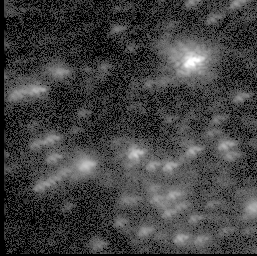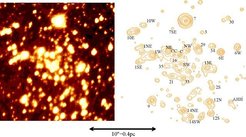
In order to get the high resolution images, we need to get rid of the distortions of the wavefront caused by the turbulent layers of the atmosphere. As it turns out, the time constant for these instantanious distortions is roughly one third second for K-Band. To the left is an animation of actual data. One can see how the turbulent atmosphere causes the distorted images of the stars to change all the time. As long as the field of view is less than the isoplanatic patch size (which is true for our pictures), every star shows the same distortions. This is an effect of the finite size of the bubbles in the atmosphere which cause the distortions and makes it possible that, by comparing several thousands of pictures, the information at the diffraction limit of a telescope can be retreived.
The image below shows the central parsec of the galaxy. On the left, a Simple Shift-and-Add mosaic is shown. It was recorded in April 1994 using the SHARP I camera mounted on the NTT on La Silla. On the right, a contour plot of the image with identifications of the brightest stars is given. The compact radio source Sgr A*, which we have shown to be a massive black hole, is just above the "SW" east of the IRS 16 cluster.


